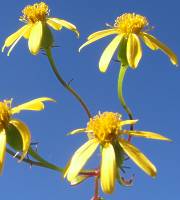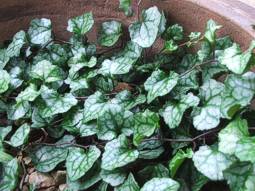Senecio bryoniifolius
Senecio bryoniifolius Harv.
Family: Asteraceae
Common names: Bryony-leaved flowering ivy
Introduction
The Bryony-leaved flowering ivy (Senecio bryoniifolius) is a succulent-leaved creeper from the Eastern Cape and KwaZulu-Natal which shows promise as a garden and house plant.

Description
Description
Succulent, evergreen creepers with a scandent growth to about 10 m high. The young vigorous growth points have a twining habit enabling the plant to climb, and the leaf petioles which point down, aid in anchoring the plant. Stems and leaves are without hairs (glabrous), the leaves are alternately arranged, and the nodes are about 10-100 mm apart. Leaves are spreading and variable in size, colour and succulence. The leaf blades are triangular-heart-shaped, about 30-65 mm long, 30-85 mm broad and on leaf stalks (petioles) 10-20 mm long. The leaf margin is variable, usually irregularly and shallowly 3-5-lobed, with many smaller teeth (dentate) or rarely without teeth (margin entire). The surface is shiny, smooth and dark green, (some forms have a beautiful silvery mottled pattern), dark purple below, 3-5-nerved, the veins forming a network pattern (reticulate).
The inflorescences (terminal corymbs) are carried at the branch ends and consist of 3-10 flower heads on inflorescence stalks (peduncles) up to 60 mm long with 1 or 2 small linear bracts. The flower heads are about 40 mm in diameter with fully opened flowers. The ray florets are about 16 x 6 mm. The heads (involucre without ray florets) are about 10 x 6 mm in diameter. Seeds are oblong, 3 mm long bearing a tuft of many white hairs 7 mm long.


The flower heads of this beautiful daisy are reminiscent of those of the related popular flowering ivy (Senecio macroglossus). According to Herman et al. (2004) South Africa and Namibia accommodate 314 Senecio species of which 45 are succulent. The genus Senecio is the largest genus in the daisy family.
Flowering time: summer & autumn.
Distribution and habitat
Distribution description
The Bryony-leaved flowering ivy (Senecio bryoniifolius) occurs widespread in the Eastern Cape from the Kei River near East London to the southern Lebombo Mountains (Zululand) in northern KwaZulu-Natal. Its habitat is mainly in Eastern Valley Bushveld, and plants are mostly associated with dense thicket vegetation in dry river valleys. The plant also grows in the coastal forest vegetation in Pondoland-Ugu Sandstone Coastal Sourveld (Indian Ocean Coastal Belt) (Mucina & Rutherford 2006).
The climate is hot and dry and rain falls mainly from spring to autumn, averaging about 1000-1250 mm per annum. At Mamba Valley (Nguni River), Durban, plants were found on cliffs in association with Commiphora harveyi, Gasteria croucheri subsp. pendulifolia, Rhipsalis baccifera, Scadoxus membranaceus, Senecio medley-woodii, Gerrardanthus macrorhizus, Petopentia natalensis and Crassula orbicularis. Plants are scandent on shrubs and trees, but not very common, in shade, partial shade or full sun.
Derivation of name and historical aspects
History
The specific epithet bryoniifolius pertains to the resemblance to the bryony plant commonly found in Eurasia (genus Bryonia, Cucurbitaceae). Senecio bryoniifolius was named by William Harvey (botanist from Dublin, Ireland) in Flora Capensis 3: 404 in 1894. The plants depicted here were collected on a National Botanical Institute expedition to KwaZulu-Natal (Kirstenbosch National Botanical Garden 90/93). Vegetative material (cuttings) was collected at Devils Knuckles along the Mtamvuna River in southern KwaZulu-Natal on 27 May 1991.
Ecology
Ecology
Senecio bryoniifolius grows in dry thicket and forest vegetation, and plants are scandent in trees with the young branches twining. The succulent leaves contribute to its drought tolerance especially during the dry winters. The plant flowers during autumn, and its bright conspicuous flowers are pollinated by insects.
Uses
Use
No uses have been recorded.
Growing Senecio bryoniifolius
Grow

Propagation
Best grown from cuttings during the warmer months (spring to autumn), the cuttings to be about 50 to 100 mm in length, the lower leaves can be removed, planted in sand or a mixture of sand and peat. Rooting is rapid and a mist unit is not necessary.
Cultivation
Senecio bryoniifolius 'Elsa Pooley',a very attractive form with silvery mottled heart-shaped leaves (dark purple below) has been selected from southern KwaZulu-Natal and was named for Elsa Pooley, eminent botanist and author of a number of books on KwaZulu-Natal plants: Trees of Natal, Zululand and Transkei (1993), Wild flowers of Natal (1998) and Mountain Flowers and A field guide to the Flora of the Drakensberg and Lesotho (2003). This superior form was collected by the Liesl van der Walt, Hildegardt Crouss and the author at Devils Knuckles along the banks of the Umtamvuna River in southern KwaZulu-Natal. Plants thrive in cultivation as a pot plant and can also be grown on fences and pergolas in subtropical parts where frost is not a problem.
References
- Dyer, R.A. 1938. The Flowering Plants of South Africa 18: t.696.
- Gunn, M. & Codd, L.E. 1981. Botanical exploration of Southern Africa. A.A. Balkema, Cape Town.
- Harvey, W.H. 1894. Flora Capensis (Rubiaceae to Campanulaceae), vol. 3: 404.
- Herman, P.P.J., Welman, W.G., Retief, E., Koekemoer M. & Netnou, N. 2004. Asteraceae. In G. Germishuizen & N.L. Meyer (eds), Plants of southern Africa : an annotated checklist. Strelitzia 14: 938.
- Mucina, L. & Rutherford, M.C. (eds) 2006. The vegetation of South Africa, Lesotho and Swaziland. Strelitzia 19. South African National Biodiversity Institute, Pretoria.
- Pooley, E. 1993. Trees of Natal, Zululand and Transkei. Natal Flora Publications Trust, Durban.
- Pooley, E. 1998. A field guide to wild flowers KwaZulu-Natal and the Eastern Region. Natal Flora Publications Trust, Durban.
- Pooley, E. 2003. Mountain Flowers, a field guide to the flora of the Drakensberg and Lesotho. Natal Flora Publications Trust, Durban.
Credits
Ernst van Jaarsveld
Kirstenbosch National Botanical Garden
May 2010
Plant Attributes:
Plant Type: Climber, Succulent
SA Distribution: Eastern Cape, KwaZulu-Natal
Soil type: Loam
Flowering season: Late Summer, Autumn
PH: Acid, Neutral
Flower colour: Yellow
Aspect: Full Sun, Shade
Gardening skill: Easy
Special Features:
Horticultural zones









Rate this article
Article well written and informative
Rate this plant
Is this an interesting plant?
Login to add your Comment
Back to topNot registered yet? Click here to register.